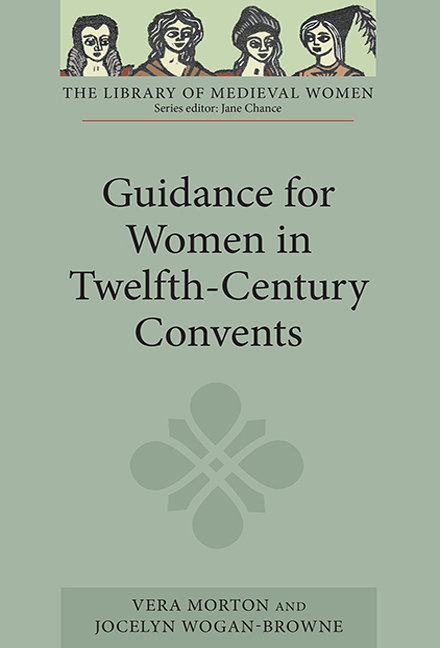Book contents
- Frontmatter
- Contents
- Preface
- Acknowledgements
- Abbreviations
- Introduction
- Note on Texts and Translations
- I Osbert of Clare, Prior of Westminster, to Adelidis, Abbess of Barking: A Thank-You Letter on Holy Widows, Virgin Fecundity and Precedents for Female Authority (Letter 42)
- II Abelard to Heloise: The History of Women's Roles in Christianity (Letter 7)
- III Peter the Venerable to his Nieces Margaret and Pontia: Of Nieces and Grandmothers and the Virgin Life at Marcigny (Letter 185)
- IV Osbert of Clare to his Nieces Margaret and Cecilia in Barking Abbey: Heavenly Rewards for Virgins in Barking (Letters 21 and 22)
- V Abelard to Heloise: On Educating Virgins (Letter 9)
- VI Goscelin of St Bertin: Lives of the Abbesses at Barking (Extracts)
- Interpretive Essay
- Bibliography
- Index
- Index
- Miscellaneous Endmatter
VI - Goscelin of St Bertin: Lives of the Abbesses at Barking (Extracts)
Published online by Cambridge University Press: 29 April 2017
- Frontmatter
- Contents
- Preface
- Acknowledgements
- Abbreviations
- Introduction
- Note on Texts and Translations
- I Osbert of Clare, Prior of Westminster, to Adelidis, Abbess of Barking: A Thank-You Letter on Holy Widows, Virgin Fecundity and Precedents for Female Authority (Letter 42)
- II Abelard to Heloise: The History of Women's Roles in Christianity (Letter 7)
- III Peter the Venerable to his Nieces Margaret and Pontia: Of Nieces and Grandmothers and the Virgin Life at Marcigny (Letter 185)
- IV Osbert of Clare to his Nieces Margaret and Cecilia in Barking Abbey: Heavenly Rewards for Virgins in Barking (Letters 21 and 22)
- V Abelard to Heloise: On Educating Virgins (Letter 9)
- VI Goscelin of St Bertin: Lives of the Abbesses at Barking (Extracts)
- Interpretive Essay
- Bibliography
- Index
- Index
- Miscellaneous Endmatter
Summary
Abbesses had a wide range of responsibilities in the spiritual and tpractical care of their monastic estates. These are demonstrated in this section through the example of the concern of successive abbesses of Barking with arrangements for various kinds of burials. The organization and maintenance of cemeteries and shrines are matters of practical concern and symbolic importance: they reflect earthly concerns with hierarchy, prestige and ritual as these shaped the identity of the living community. The dead themselves, as the following extracts show, were seen as vigorously participating in and guiding this sense of identity: their status and reputation continued to provide patronage from heaven.
The source of information here is the rewriting of the lives of the abbesses of Barking, most probably carried out between 1086 and 1100, by Goscelin of St Bertin. This Flemish cleric travelled widely in England and seems to have been in demand as a refurbisher of the histories and cults of monastic houses. In updating the Barking lives, Goscelin drew on earlier Latin lives, especially the accounts in the prestigious Ecclesiastical History of the Venerable Bede (AD 673–735). He supplemented written sources with the nuns’ own memories and knowledge of the house's traditions. The occasion for this updating at Barking was probably Abbess Elfgiva's desire to re-bury the bodies of her predecessors in a larger and grander shrine. Goscelin's Life of Ethelburga is dedicated to Bishop Maurice of London (consecrated April 1086), and Elfgiva seems to have asked Goscelin to prepare the new life in addition to the two extant narratives of the creation of new shrines in the abbey church (probably to help persuade the new Norman bishop to support the translation of these Anglo-Saxon saints).
Re-burials, or ‘translations’ are a frequent feature in the cult of saints and in the development of monasteries: they often created increased prestige, pilgrimage, and revenues and accounts of them constitute a sub-genre of hagiographic writing. The royal and noble foundresses of the major Anglo-Saxon nunneries were usually culted as saints by their successors, both before and after the Norman Conquest. Continuity became very important to the Normans, who, after the first post-Conquest generations, reinvented cults and histories of Anglo-Saxon saints and institutions as their own history in Britain.
- Type
- Chapter
- Information
- Guidance for Women in Twelfth-Century Convents , pp. 139 - 156Publisher: Boydell & BrewerPrint publication year: 2003



